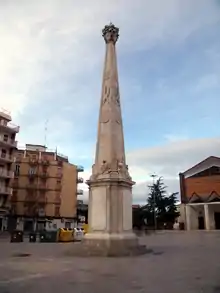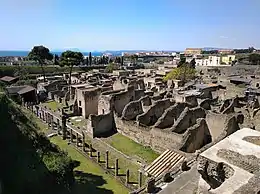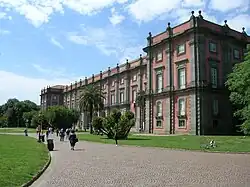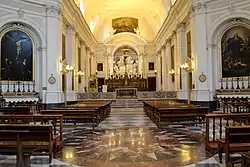Giovanni Antonio Medrano (11 December, 1703–1760)[1] was the "Major Regius Praefectus Mathematicis Regni Neapolitani" (Major Royal Governor of Mathematics of the Kingdom of Naples), chief engineer of the kingdom, architect, brigadier, and teacher of Charles III of Spain and his brothers the infantes. Giovanni was born in Sciacca in the Kingdom of Sicily. Giovanni designed the Obelisk of Bitonto, the Palace of Capodimonte and the Teatro di San Carlo in Italy for Charles III of Spain. Medrano’s career is particularly studied, from his stay in Seville as a teacher for the royal princes, and his influence on Prince Charles’ architectural taste, to his projects in the Kingdom of Naples and the royal palace at Capodimonte.[1]
Education of Charles III and the Infantes
The Medrano family had close ties to the Spanish Monarchs. In fact, the Regency of the Royal Council of Navarre from May 9th 1702 to 1705 under Don Pedro Antonio de Medrano for King Philip V confirms this.[2]

During this Andalusian period, Giovanni Antonio Medrano began to deal with the military and architectural education of the Infante Don Carlos and his brothers the infantes Louis I, Ferdinand VI, Philip, and Luis, Count of Chinchón; of these tasks, for "instruction and amusement of the Most Serene Prince our Lord and Lords Infantes", there are two plans of a Fort, erected between 1729 and 1730 in Buenavista, on the outskirts of Seville, which included a ravelin dedicated to the Infante don Carlos himself.[1]
In December 1731, Medrano accompanied King Philip V's sixteen-year-old son, Charles of Bourbon, Duke of Parma and Piacenza, to Livorno, as an ordinary engineer and with the rank of lieutenant. From 1732 to 1734 he remained in the service of the Infante, teaching him geography, history and mathematics, as well as military art and architecture during his stay in the cities of Florence, Parma and Piacenza.[1]
Rise in Ranks
The fact that Giovanni Antonio Medrano was promoted in 1733 to lieutenant and ordinary engineer and, later and already in Naples, in 1737, to brigadier and chief engineer, testifies to his efforts and work. After the coronation of Charles as king of Naples and Sicily in 1734, probably due to his close bond with the young sovereign, but more generally for reasons related to the need for the government to have more direct control over the entire local system of public works, Medrano was invested with some of the most prestigious and strategic positions of a public nature initiated by the Bourbons in the capital.[1]
While still a teenager, he moved with his family to Spain, where he embarked on a military career within the royal corps of engineers created in 1711 by King Philip V of Bourbon.[3] Giovanni had entered the service of Spain in 1719 as a Military Architect, although it is probable that Giovanni had already joined the army of the Marquess of Verboom Jorge Próspero de Verboom in the Sicilian campaign of 1718, since in December of that same year he appeared as extraordinary engineer and sub-lieutenant of this body.[4]
The Marquess of Verboom was one of the best students to come out of the Royal Military and Mathematics Academy of Brussels (1675–1706), personally taught by the sole director and Master of Mathematics Don Sebastián Fernández de Medrano in order to train the most distinguished officers and military engineers in various fields of education such as arithmetic, geometry, artillery, fortification, algebra, cosmography, astronomy, navigation, etc. Among those fields, the education of arithmetic, geometry, and fortification were particularly important and related to one another.[5][6]
.jpg.webp)
As an extraordinary engineer and with the rank of second lieutenant Giovanni Antonio Medrano participated in the Spanish campaign to reconquer Sicily in December 1718 and two years later he was assigned to the garrisons of Catalonia, Valencia and Murcia, specializing in the design of large territorial infrastructures and plants for the military defence, such as Montjuïc Castle in Barcelona which he drew up in 1730.[1]
Giovanni reappears in 1729, when Medrano was commissioned to organize the roads for the journey of the royal family, headed by Philip V and Isabel de Farnese, from Madrid to Seville.[7]
Medrano also appears as "Major Regius Praefectus Mathematicis Regni Neapolitani"(Major Royal Governor of Mathematics of the Kingdom of Naples) even apparently a year before he was named chief engineer of the kingdom, a title he did not receive until 1735.[4]
Cuccagna for the Royal Wedding
Also, on the occasion of the festivities for the marriage of Carlos with Maria Amalia of Saxony, Princess of Poland, that same year a cuccagna designed by Medrano was erected on the Chiaia waterfront in front of the church of San Leonardo. It took the form of an old castle, with four corner towers and a central one, bastions, moats, battlements, embrasures and sentry boxes, as well as two ravelins with parapets and new sentry boxes.[1]
Palace of the Viceroy of Naples and trip to Sicily with the King
.jpg.webp)
Back in Naples, Medrano was employed in 1734, without knowing the scope of his work, on the Royal Palace of Naples built by Domenico Fontana. Between 1734 and 1738 he supervised the renovation and expansion works of the viceregal palace (1734). In January 1735, he accompanied the King, already as Senior Engineer of the Kingdom and Lieutenant Colonel, on his trip to Sicily, in the company of Michelangelo de Blasio, also an engineer, who was, however, arrested on charges of treason in the month February.[7]
The Obelisk of Bitonto

Medrano became a brigadier in the army of Charles of Bourbon, while he was king of Naples and Sicily. Among the first professional commitments undertaken by Medrano in the Kingdom of Naples was the project of an obelisk to be built in Bitonto to celebrate the victorious outcome of the Bourbons over the Habsburgs in the battle of May 1734. Located in the current square, the Carolinian obelisk, begun in 1736, was conceived by Giovanni Antonio Medrano in a truncated pyramid shape with inscriptions on the four sides attributed to B. Tanucci, for a vertical development of about 18 metres. Outside the capital, in that same period, Medrano was also in charge of the construction on the Volturno, at the royal site of Venafro, of an imposing factory bridge, called di Torcino, which, destroyed by a flood of the river, was rebuilt around to 1750 by the engineer F. Gasperi.[7]
Designing the San Carlo Opera House

In 1737, Charles commissioned Giovanni Antonio Medrano to design the new San Carlo opera house in Naples.[1] The Teatro Reale di San Carlo, as originally named by the Bourbon monarchy but today known simply as the Teatro di San Carlo, is an opera house in Naples, Italy, connected to the Royal Palace of Capodimonte and adjacent to the Piazza del Plebiscito. Giovanni Antonio Medrano took charge of the project. Angelo Carasale, the former director of the San Bartolomeo held the primary responsibility for designing the elaborate furnishings of the Teatro di San Carlo. The San Carlo theater, designed in 1737 by Medrano, was completed after only eight months, in October of the same year.
Thus, the San Carlo designed by Giovanni Antonio Medrano was inaugurated on 4 November 1737, the king's name day, with the performance of the opera Domenico Sarro's Achille in Sciro, which was based on the 1736 libretto by Metastasio which had been set to music that year by Antonio Caldara. As was customary, the role of Achilles was played by a woman, Vittoria Tesi, called "Moretta"; the opera also featured soprano Anna Peruzzi, called "the Parrucchierina" and tenor Angelo Amorevoli. Sarro also conducted the orchestra in two ballets as intermezzi, created by Gaetano Grossatesta, with scenes designed by Pietro Righini.[8] The first seasons highlighted the royal preference for dance numbers, and featured among the performers famous castrati. In the late 18th century, Christoph Willibald Gluck was called to Naples by the impresario Tufarelli to direct his 1752 Clemenza di Tito at the theatre, and Johann Christian Bach in 1761–62 brought two operas, Catone in Utica and Alessandro nell'Indie.
The world's oldest opera house, the Teatro di San Carlo in Italy, has survived wars, fires and the Neapolitan revolution. Characterized by Medrano's typical "horseshoe" layout,[9] with a semicircular profile towards the back of the stalls and straight connections towards the proscenium, the complex was also reproduced in the Recueil de planches of the Encyclopédie,[10] on the basis of surveys previously produced and published by GPM Dumont.
Excavations of Herculaneum

In 1738, with the engineer from Zaragoza, Roque Joaquín de Alcubierre, Giovanni Antonio Medrano was commissioned by King Charles to begin the excavations of Herculaneum, giving rise to a new type of activity.[4] According to the traditional tale, the city was rediscovered by chance in 1709, during the drilling of a well. Remnants of the city, however, were already found during earlier earthworks.[11] In the years following the site's uncovering, treasure seekers excavated tunnels and took artifacts. Regular excavations commenced in 1738 and have continued irregularly since. Today, only a fraction of the ancient site has been excavated. The focus has shifted to preserving the already-excavated portions of the city rather than exposing more. Excavations continued sporadically up to the present and today many streets and buildings are visible, although over 75% of the town remains buried. The publication of "Le Antichità di Ercolano" ("The Antiquities of Herculaneum") had a striking influence on nascent European Neoclassicism; by the end of the 18th century, motifs from Herculaneum began to appear on fashionable furnishings, including decorative wall-paintings, tripod tables, perfume burners, and teacups. Nonetheless, excavation ceased once again in 1762 as a result of Winckelmann's harsh criticism of the treasure-hunting techniques.[12]
Designing the Palace of Capodimonte

King Carlos understood the need to create a system of self-representation capable of manifesting his new political identity in the context of the highly competitive Neapolitan society. According to the specific idea of majesty they meant to highlight, old and new images, ceremonies and spaces for the new Neapolitan monarchy were created or, at least, reshaped from 1734 onwards. Giovanni Antonio Medrano was employed to design the palaces necessary to enact Don Carlos’s new status, while a royal household and court etiquette were also established.[13] Giovanni Antonio Medrano went on to design the Palace of Capodimonte, Charles's new palace in Naples. Medrano started work on this in 1738, but the building was not finally completed until 1840.[13]
Medrano was the most important designer in the palace’s history. The king showed the utmost interest in the building, demanding weekly updates on its progress and even insisting on changes. Though it took a century to complete, royal enthusiasm for the project did not fade because of its design. What undermined the project was that the palace was built over a series of ancient chasms, requiring more work and expense than anticipated.[14]
First promoted to brigadier and then major engineer of the kingdom, in the short span of time between 1734 and 1738 he supervised the renovation and expansion works of the viceregal palace (1734), he worked on restoration projects on the Palazzo dei Regi Studi (1735 ), designed the San Carlo theater (1737) and started the planning and the first phase of the construction sites of the Royal Palace of Portici (1737–38). In later years he took over from Antonio Canevari as sole architect of the new palace of Capodimonte.[13] The court, while sharing his expansive vision, did not possess patience for Canevari. After Canevari had worked for ten months without resolving on a single solution, Medrano took action.[14]
King Charles, still unrecognized as a legitimate monarch by some European courts, knew that the Bourbon hold on Southern Italy depended on his ability to give birth to an heir and dynasty. Producing a son was no inconsequential matter: two major wars of the eighteenth century erupted after the failure of the Habsburg dynasty to do so. So while Medrano was at the draftsman’s table, it was far from certain that Charles’s reign would endure. Medrano therefore boldly anticipated the permanence of the royal family by spatially solidifying a place for them in the Palace of Capodimonte. Other aspects of the plan confirm the broader political importance of the palace.[14]

Its cubic regularity, divided into thirds by the two courtyards and stair hall, reflects the king’s consistent insistence on geometric clarity in his architectural commissions. The gridded layout related buildings in Naples to the Herrerian style of Spanish royal retreats, such as the rectilinear cube of El Pardo and the multiple courts of El Escorial, drawing upon the austere authority and permanence that those structures provided. The projecting corners replicated, in form and function, the royal bedroom suite of Fontana’s Palazzo Reale. The stairs are grander elaborations of the staircase of the Teatro di San Carlo, which had been designed by Medrano as an extension of the Palazzo Reale. The theater had one central monumental staircase linked by two smaller ones, whereas the palace was to have two principal ones. Like the palace, the theater’s central steps embraced an open hall with lights formed in a C shape. At Capodimonte this form was doubled, so that two C-shaped staircases face each other across an open hall.[14]
The features drawn from Spain, the Teatro di San Carlo, and the Palazzo Reale indicate that Medrano oversaw the design. He knew Spanish monuments well, renovated the Palazzo Reale, and built the theater. Medrano probably designed the stairs, for their distinctive C-shaped lights resemble the one he designed for San Carlo.[14]
Their enormous cost prompted the inquest that lead to Medrano’s imprisonment. His trial, the great distance from quarries, and an insufficient supply of fresh water led the court to refocus efforts at Portici, and later, Royal Palace of Caserta. Though only the parts of the building to the south and east were complete by the time Charles left Naples to become King of Spain in 1759, the palace set important precedents. Its geometric simplicity was admired, and would guide similar planning at Caserta. Its plan also appears to have served as a model for Charles’s expansion of El Pardo, near Madrid, in the 1770s.[14]
Sentence at the Peñon Garrison (1743–1746)
Starting from the summer of 1741 Giovanni Antonio Medrano began to lose control and supervision of the numerous construction sites that had been entrusted to him: from the works for the quay of the new port of Naples (1740) which continued under the expert direction of the military engineer G. Bompiede to those of the new cavalry district on the Riviera di Chiaia (1740), up to the continuation of the projects and works for the new palace of Portici, which were definitively entrusted to Canevari. The well-documented forensic allegations produced by the Neapolitan lawyer N.M. Pirelli for the defense of Medrano, who, after eighteen months in prison and on charges of collusion and omission of official documents, on 25 September 1743 he was dismissed from all positions, demoted and sentenced to five years of closed garrison. Giovanni Antonio Medrano served his sentence at the military garrison of Peñon, where he was engaged in 1746 in the project for the plan of the fortress and the bay of Gibraltar.[15]
Return to Naples and Death
He obtained a pardon with the respective reduction of the sentence and returned to Italy in 1746, but his professional figure was severely attacked by fierce criticism from the Neapolitan engineers of the time. With these heavy criticisms he was marginalized from public offices.[15]
Trinità dei Pellegrini

Having arrived in Naples, Giovanni Antionio Medrano managed to carve out his own professional space and, from 1749 to 1754, was in charge of the restructuring of all the buildings of the Archconfraternity of the Santissima Trinità dei Pellegrini, including the church, which he conceived according to a Latin cross layout. A project which, however, during the construction phase was reduced to the premises of the crypt and to the arrangement, in collaboration with M. Gioffredo and N. Tagliacozzi Canale, of the houses owned by the Archconfraternity itself, located between the church and Porta Medina.[7] The choir of the church (1754) was designed by Giovanni Antonio Medrano with a rich decoration, also in stucco. Apart from the renovation project of the building complex owned by Giuseppe De Maio Durazzo (1752), that of the Ss. Trinità dei Pellegrini probably constituted the last experience conducted in Naples by Giovanni Antonio Medrano. Excluded from large public construction sites since 1743 and since then marginalized with respect to the local professional and political circles, Giovanni Antionio Medrano had perhaps the only reason for his stubborn insistence on residing in Naples in family ties with G. Almirante, daughter of the Duke of Cerza Piccola and already widow of D. Toraldo, Baron of Calimera, with whom she had stipulated a marriage contract in 1736. After the inauguration of the choir ("terrasanta") in the church of the Ss. Trinità dei Pellegrini (1754), Giovanni Antonio Medrano was no longer active in any professional experience until his death, probably in 1760.[7]
References
- 1 2 3 4 5 6 7 8 Marías, Fernando (2005). "Entre Sevilla y Napoles: Juan Antonio Medrano, Ferdinando Sanfelice y los Borbones de España de Felipe V a Carlos III". Atrio. Revista de Historia del Arte (10–11): 5.
- ↑ "Pedro Antonio Medrano Albelda | Real Academia de la Historia. This title has an important detail, since it is the only document appointing a regent that was not signed by the King in the entire eighteenth century. Felipe V was absent in Italy and the one who replaced him in the heading was Cardinal Portocorrero. Medrano had already reported his appointment to the Provincial Council with a letter dated in Valladolid on April 4". dbe.rah.es. Retrieved 2023-08-05.
- ↑ "The Spanish Royal Corps of Engineers in the Western Borderlands: Instrument of Bourbon Reform 1764 to 1815". San Diego History Center | San Diego, CA | Our City, Our Story. Retrieved 2023-11-16.
- 1 2 3 The University of Madrid https://rio.upo.es/xmlui/bitstream/handle/10433/2593/296-601-1-SM.pdf?sequence=1&isAllowed=y
- ↑ "Contenido – Spanish army". ejercito.defensa.gob.es. Retrieved 2023-09-22.
- ↑ Geográfica (Spain), Real Sociedad (1906). Boletín (in Spanish).
- 1 2 3 4 5 "MEDRANO, Giovanni Antonio". Dizionario Biografico degli Italiani – Volume 73 (2009) (in Italian). Enciclopedia Italiana. Retrieved 20 February 2012.
- ↑ "Historical highlights".
- ↑ https://www.researchgate.net/figure/Giovanni-Antonio-Medrano-1735-Plan-of-the-San-Carlo-Theatre-Naples-Reproduced-with_fig2_48829025
- ↑ (Paris 1772, sv Théâtres , tab. I and II)
- ↑ Wallace-Hadrill, Andrew (2011). Herculaneum: Past and Future. ISBN 978-0-7112-3142-9. p47
- ↑ Wallace-Hadrill, Andrew (2011). Herculaneum: Past and Future. ISBN 978-0-7112-3142-9. p62
- 1 2 3 Gestal, Pablo Vázquez (2009-01-01). ""From Court Painting to King's Books: Displaying Art in Eighteenth-Century Naples (1734–1746)" in Susan Bracken; Andrea Gáldy & Adriana Turpin (eds.), Collecting & Dynastic Ambition. Newcastle: Cambridge Scholars Publishing, 2009. 85–107". From Court Painting to King's Books: Displaying Art in Eighteenth-Century Naples (1734–1746).
- 1 2 3 4 5 6 Thomas, Robin (2016-01-01). "The Royal Palace of Capodimonte: the Early Years". Napoli Nobilissima Volume Lxxii dell'intera Collezione Rivista di Arti, Filologia e Storia Settima Serie -Volume Ii Fascicolo III -Settembre -Dicembre 2016.
- 1 2 "MEDRANO, Giovanni Antonio in "Dizionario Biografico"". www.treccani.it (in Italian). Retrieved 2023-08-30.